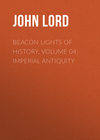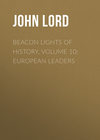Czytaj książkę: «Beacon Lights of History, Volume 3 part 1: The Middle Ages», strona 15
In one aspect they are absolutely repulsive; and this in view of their vices. The crusaders were cruel. They wantonly massacred their enemies, even when defenceless. Sixty thousand people were butchered on the fall of Jerusalem; ten thousand were slaughtered in the Mosque of Omar. The Christians themselves felt safe when they sought the retreat of churches, in dire calamities at home; but they had no respect for the religious retreats of infidels. When any city fell into their hands there was wholesale assassination. And they became licentious, as well as rapacious and cruel. They learned all the vices of the East. Even under the walls of Acre they sang to the sounds of Arabian instruments, and danced amid indecent songs. When they took Constantinople they had no respect for either churches or tombs, and desecrated even the pulpit of the Patriarch. Their original religious zeal was finally lost sight of entirely in their military license. They became more hateful to the orthodox Greeks than to the infidel Saracens. And when the crusaders returned to their homes,—what few of them lived to return,—they morally poisoned the communities and villages in which they dwelt. They became vagabonds and vagrants; they introduced demoralizing amusements, and jugglers and strolling players appeared for the first time in Europe. All war is necessarily demoralizing, even war in defence of glorious principles, and especially in these times; but much more so is unjust, fanatical, and unnecessary war.
But I turn from the record of the mistakes, follies, vices, miseries, and crimes which marked the wickedest and most uncalled- for wars of European history, to consider their ultimate results: not logical results, for these were melancholy,—the depopulation of Europe; the decimation of the nobility; the poverty which enormous drains of money from their natural channels produced; the spread of vice; the decline of even feudal virtues. These evils and others followed naturally and inevitably from those distant wars. The immediate effects of all war are evil and melancholy. Murder, pillage, profanity, drunkenness, extravagance, public distress, bitter sorrows, wasted energies, destruction of property, national debts, exaltation of military maxims, general looseness of life, distaste for regular pursuits,—these are the first-fruits of war, offensive and defensive, and as inevitable and uniform as the laws of gravity. No wars were ever more disastrous than the Crusades in their immediate effects, in any way they may be viewed. It is all one dark view of disappointment, sorrow, wretchedness, and sin. There were no bright spots; no gains, only calamities. Nothing consoled Europe for the loss of five millions of her most able-bodied men,—no increase of territory, no establishment of rights, no glory, even; nothing but disgrace and ruin, as in that maddest of all modern expeditions, the invasion of Russia by Napoleon.
But after the lapse of nearly seven hundred years we can see important results on the civilization of Europe, indirectly effected,—not intended, nor designed, nor dreamed of; which results we consider beneficent, and so beneficent that the world is probably better for those horrid wars. It was fortunate to humanity at large that they occurred, although so unfortunate to Europe at the time. In the end, Europe was a gainer by them. Wickedness was not the seed of virtue, but wickedness was overruled. Woe to them by whom offences come, but it must need be that offences come. Men in their depravity will commit crimes, and those crimes are punished; but even these are made to praise a Power superior to that of devils, as benevolent as it is omnipotent,—in which fact I see the utter hopelessness of earth without a superintending and controlling Deity.
One important result of the Crusades was the barrier they erected to the conquests of the Mohammedans in Europe. It is true that the wave of Saracenic invasion had been arrested by Charles Martel four or five hundred years before; but in the mean time a new Mohammedan power sprang up, of greater vigor, of equal ferocity, and of a more stubborn fanaticism. This was that of the Turks, who had their eye on Constantinople and all Eastern Europe. And Europe might have submitted to their domination, had they instead of the Latins taken Constantinople. The conquest of that city was averted several hundred years; and when at last it fell into Turkish hands. Christendom was strong enough to resist the Turkish armies. We must remember that the Turks were a great power, even in the times of Peter the Great, and would have taken Vienna but for John Sobieski. But when Urban II., at the Council of Clermont, urged the nations of Europe to repel the infidels on the confines of Asia, rather than wait for them in the heart of Europe, the Asiatic provinces of the Greek Empire were overrun both by Turks and Saracens. They held Syria, Armenia, Asia Minor, Africa. Spain, and the Balearic Islands. Had not Godfrey come to the assistance of a division of the Christian army, when it was surrounded by two hundred thousand Turks at the battle of Dorylaeum, the Christians would have been utterly overwhelmed, and the Turks would have pressed to the Hellespont. But they were beaten back into Syria, and, for a time, as far as the line of the Euphrates. But for that timely repulse, the battles of Belgrade and Lepanto might not have been fought in subsequent ages. It would have been an overwhelming calamity had the Turks invaded Europe in the twelfth century. The loss of five millions on the plains of Asia would have been nothing in comparison to an invasion of Europe by the Mohammedans,—whether Saracens or Turks. It may be that the chivalry of Europe would have successfully repelled an invasion, as the Saracens repelled the Christians, on their soil. It may be that Asia could not have conquered Europe any easier than Europe could conquer Asia.
I do not know how far statesmanlike views entered into the minds of the leaders of the Crusades. I believe the sentiment which animated Peter and Urban and Bernard was pure hatred of the Mohammedans (because they robbed, insulted, and oppressed the pilgrims), and not any controlling fears of their invasion of Europe. If such a fear had influenced them, they would not have permitted a mere rabble to invade Asia; there would have been a sense of danger stronger than that of hatred,—which does not seem to have existed in the self-confidence of the crusaders. They thought it an easy thing to capture Jerusalem: it was a sort of holiday march of the chivalry of Europe, under Richard and Philip Augustus. Perhaps, however, the princes of Europe were governed by political rather than religious reasons. Some few long-headed statesmen, if such there were among the best informed of bishops and abbots, may have felt the necessity of the conflict in a political sense; but I do not believe this was a general conviction. There was, doubtless, a political necessity—although men were too fanatical to see more than one side—to crush the Saracens because they were infidels, and not because they were warriors. But whether they saw it or not, or armed themselves to resist a danger as well as to exterminate heresy, the ultimate effects were all the same. The crusaders failed in their direct end. They did not recover Palestine; but they so weakened or diverted the Mohammedan armies that there was not strength enough left in them to conquer Europe, or even to invade her, until she was better prepared to resist it,—as she did at the battle of Lepanto (A. D. 1571), one of the decisive battles of the world.
I have said that the Crusades were a disastrous failure. I mean in their immediate ends, not in ultimate results. If it is probable that they arrested the conquests of the Turks in Europe, then this blind and fanatical movement effected the greatest blessing to Christendom. It almost seems that the Christians were hurled into the Crusades by an irresistible fate, to secure a great ultimate good; or, to use Christian language, were sent as blind instruments by the Almighty to avert a danger they could not see. And if this be true, the inference is logical and irresistible that God uses even the wicked passions of men to effect his purposes,—as when the envy of Haman led to the elevation of Mordecai, and to the deliverance of the Jews from one of their greatest dangers.
Another and still more noticeable result of the Crusades was the weakening of the power of those very barons who embarked in the wars. Their fanaticism recoiled upon themselves, and undermined their own system. Nothing could have happened more effectually to loosen the rigors of the feudal system. It was the baron and the knight that marched to Palestine who suffered most in the curtailment of the privileges which they had abused,—even as it was the Southern planter of Carolina who lost the most heavily in the war which he provoked to defend his slave property. In both cases the fetters of the serfs and slaves were broken by their own masters,—not intentionally, of course, but really and effectually. How blind men are in their injustices! They are made to hang on the gallows which they have erected for others. To gratify his passion of punishing the infidels, whom he so intensely hated, the baron or prince was obliged to grant great concessions to the towns and villages which he ruled with an iron hand, in order to raise money for his equipment and his journey. He was not paid by Government as are modern soldiers and officers. He had to pay his own expenses, and they were heavier than he had expected or provided for. Sometimes he was taken captive, and had his ransom to raise,—to pay for in hard cash, and not in land: as in the case of Richard of England, when, on his return from Palestine, he was imprisoned in Austria,—and it took to ransom him, as some have estimated, one third of all the gold and silver of the realm, chiefly furnished by the clergy. But where was the imprisoned baron to get the money for his ransom? Not from the Jews, for their compound interest of fifty per cent every six months would have ruined him in less than two years. But the village guilds had money laid by. Merchants and mechanics in the towns, whom he despised, had money. Monasteries had money. He therefore gave new privileges to all; he gave charters of freedom to towns; he made concessions to the peasantry.
As the result of this, when the baron came back from the wars, he found himself much poorer than when he went away,—he found his lands encumbered, his castle dilapidated, and his cattle sold. In short, he was, as we say of a proud merchant now and then, "embarrassed in his circumstances." He was obliged to economize. But the feudal family would not hear of retrenchment, and the baron himself had become more extravagant in his habits. As travel and commerce had increased he had new wants, which he could not gratify without parting with either lands or prerogatives. As the result of all this he became not quite so overbearing, though perhaps more sullen; for he saw men rising about him who were as rich as he,– men whom his ancestors had despised. The artisans, who belonged to the leading guilds, which had become enriched by the necessities of barons, or by that strange activity of trade and manufactures which war seems to stimulate as well as to destroy,—these rude and ignorant people were not so servile as formerly, but began to feel a sort of importance, especially in towns and cities, which multiplied wonderfully during the Crusades. In other words, they were no longer brutes, to be trodden down without murmur or resistance. They began to form what we call a "middle class." Feudalism, in its proud ages, did not recognize a middle class. The impoverishment of nobles by the Crusades laid the foundation of this middle class, at least in large towns.
The growth of cities and the decay of feudalism went on simultaneously; and both were equally the result of the Crusades. If the noble became impoverished, the merchant became enriched; and the merchant lived, not in the country, but in some mercantile mart. The crusaders had need of ships. These were furnished by those cities which had obtained from feudal sovereigns charters of freedom. Florence, Pisa, Venice, Genoa, Marseilles, became centres of wealth and political importance. The growth of cities and the extension of commerce went hand in hand. Whatever the Crusades did for cities they did equally for commerce; and with the needs of commerce came improvement in naval architecture. As commerce grew, the ships increased in size and convenience; and the products which the ships brought from Asia to Europe were not only introduced, but they were cultivated. New fruits and vegetables were raised by European husbandmen. Plum-trees were brought from Damascus and sugar-cane from Tripoli. Silk fabrics, formerly confined to Constantinople and the East, were woven in Italian and French villages. The Venetians obtained from Tyrians the art of making glass. The Greek fire suggested gunpowder. Architecture received an immense impulse: the churches became less sombre and heavy, and more graceful and beautiful. Even the idea of the arch, some think, came from the East. The domes and minarets of Venice were borrowed from Constantinople. The ornaments of Byzantine churches and palaces were brought to Europe. The horses of Lysippus, carried from Greece to Rome, and from Rome to Constantinople, at last surmounted the palace of the Doges. Houses became more comfortable, churches more beautiful, and palaces more splendid. Even manners improved, and intercourse became more polished. Chivalry borrowed many of its courtesies from the East. There were new refinements in the arts of cookery as well as of society. Literature itself received a new impulse, as well as science. It was from Constantinople that Europe received the philosophy of Plato and Aristotle, in the language in which it was written, instead of translations through the Arabic. Greek scholars came to Italy to introduce their unrivalled literature; and after Grecian literature came Grecian art. The study of Greek philosophy gave a new stimulus to human inquiry, and students flocked to the universities. They went to Bologna to study Roman law, as well as to Paris to study the Scholastic philosophy.
Thus the germs of a new civilization were scattered over Europe. It so happened that at the close of the Crusades civilization had increased in every country of Europe, in spite of the losses they had sustained. Delusions were dispelled, and greater liberality of mind was manifest. The world opened up towards the East, and was larger than was before supposed. "Europe and Asia had been brought together and recognized each other." Inventions and discoveries succeeded the new scope for energies which the Crusades opened. The ships which had carried the crusaders to Asia were now used to explore new coasts and harbors. Navigators learned to be bolder. A navigator of Genoa—a city made by the commerce which the Crusades necessitated—crosses the Atlantic Ocean. As the magnetic needle, which a Venetian traveller brought from Asia, gave a new direction to commerce, so the new stimulus to learning which the Grecian philosophy effected led to the necessity of an easier form of writing; and printing appeared. With the shock which feudalism received from the Crusades, central power was once more wielded by kings, and standing armies supplanted the feudal. The crusaders must have learned something from their mistakes; and military science was revived. There is scarcely an element of civilization which we value, that was not, directly or indirectly, developed by the Crusades, yet which was not sought for, or anticipated even,– the centralization of thrones, the weakening of the power of feudal barons, the rise of free cities, the growth of commerce, the impulse given to art, improvements in agriculture, the rise of a middle class, the wonderful spread of literature, greater refinements in manners and dress, increased toleration of opinions, a more cheerful view of life, the simultaneous development of energies in every field of human labor, new hopes and aspirations among the people, new glories around courts, new attractions in the churches, new comforts in the villages, new luxuries in the cities. Even spiritual power became less grim and sepulchral, since there was less fear to work upon.
I do not say that the Crusades alone produced the marvellous change in the condition of society which took place in the thirteenth century, but they gave an impulse to this change. The strong sapling which the barbarians brought from their German forests and planted in the heart of Europe,—and which had silently grown in the darkest ages of barbarism, guarded by the hand of Providence,– became a sturdy tree in the feudal ages, and bore fruit when the barons had wasted their strength in Asia. The Crusades improved this fruit, and found new uses for it, and scattered it far and wide, and made it for the healing of the nations. Enterprise of all sorts succeeded the apathy of convents and castles. The village of mud huts became a town, in which manufactures began. As new wants became apparent, new means of supplying them appeared. The Crusades stimulated these wants, and commerce and manufactures supplied them. The modern merchant was born in Lombard cities, which supplied the necessities of the crusaders. Feudalism ignored trade, but the baron found his rival in the merchant-prince. Feudalism disdained art, but increased wealth turned peasants into carpenters and masons; carpenters and masons combined and defied their old masters, and these masters left their estates for the higher civilization of cities, and built palaces instead of castles. Palaces had to be adorned, as well as churches; and the painters and handicraftsmen found employment. So one force stimulated another force, neither of which would have appeared if feudal life had remained in statu quo.
The only question to settle is, how far the marked progress of the twelfth and thirteenth centuries may be traced to the natural development of the Germanic races under the influence of religion, or how far this development was hastened by those vast martial expeditions, indirectly indeed, but really. Historians generally give most weight to the latter. If so, then it is clear that the most disastrous wars recorded in history were made the means— blindly, to all appearance, without concert or calculation—of ultimately elevating the European races, and of giving a check to the conquering fanaticism of the enemies with whom they contended with such bitter tears and sullen disappointments.
AUTHORITIES
Michaud's Histoire des Croisades; Mailly's L'Esprit des Croisades; Choiseul; Daillecourt's De l'influence des Croisades; Sur l'Etat des Peuples en Europe; Heeren's Ueber den Einfluss der Kreuzzuge; Sporschill's Geschichte der Kreuzzuge; Hallam's Middle Ages; Mill's History of the Crusades; James's History of the Crusades; Michelet's History of France (translated); Gibbon's Decline and Fall; Milman's Latin Christianity; Proctor's History of the Crusades; Mosheim.
WILLIAM OF WYKEHAM
A. D. 1324-1404
GOTHIC ARCHITECTURE
A. D. 1100-1400
Church Architecture is the only addition which the Middle Ages made to Art; but even this fact is remarkable when we consider the barbarism and ignorance of the Teutonic nations in those dark and gloomy times. It is difficult to conceive how it could have arisen, except from the stimulus of religious ideas and sentiments,—like the vast temples of the Egyptians. The artists who built the hoary and attractive cathedrals and abbey churches which we so much admire are unknown men to us, and yet they were great benefactors. It is probable that they were practical and working architects, like those who built the temples of Greece, who quietly sought to accomplish their ends,—not to make pictures, but to make buildings,—as economically as they could consistently with the end proposed, which end they always had in view.
In this Lecture I shall not go back to classic antiquity, nor shall I undertake to enter upon any disquisition on Art itself, but simply present the historical developments of the Church architecture of the Middle Ages. It is a technical and complicated subject, but I shall try to make myself understood. It suggests, however, great ideas and national developments, and ought to be interesting.
The Romans added nothing to the architecture of the Greeks except the arch, and the use of brick and small stones for the materials of their stupendous structures. Now Christianity and the Middle Ages seized the arch and the materials of the Roman architects, and gradually formed from these a new style of architecture. In Roman architecture there was no symbolism, no poetry, nothing to represent consecrated sentiments. It was mundane in its ideas and ends; everything was for utility. The grandest efforts of the Romans were feats of engineering skill, rather than creations inspired by the love of the beautiful. What was beautiful in their edifices was borrowed from the Greeks; what was original was intended to accommodate great multitudes, whether they sought the sports of the amphitheatre or the luxury of the bath. Their temples were small, comparatively, and were Grecian.
The first stage in the development of Church architecture was reached amid the declining glories of Roman civilization, before the fall of the Empire; but the first model of a Christian church was not built until after the imperial persecutions. The early Christians worshipped God in upper chambers, in catacombs, in retired places, where they would not be molested, where they could hide, in safety. Their assemblies were small, and their meetings unimportant. They did nothing to attract attention. The worshippers were mostly simple-minded, unlettered, plebeian people, with now and then a converted philosopher, or centurion, or lady of rank. They met for prayer, exhortation, the reading of the Scriptures, the singing of sacred melodies, and mutual support in trying times. They did not want grand edifices. The plainer the place in which they assembled the better suited it was to their circumstances and necessities. They scarcely needed a rostrum, for the age of sermons had not begun; still less the age of litanies and music and pomps. For such people, in that palmy age of faith and courage, when the seeds of a new religion were planted in danger and watered with tears; when their minds were directed almost entirely to the soul's welfare and future glory; when they loved one another with true Christian disinterestedness; when they stimulated each other's enthusiasm by devotion to a common cause (one Lord, one faith, one baptism); when they were too insignificant to take any social rank, too poor to be of any political account, too ignorant to attract the attention of philosophers,—ANY place where they would be unmolested and retired was enough. In process of time, when their numbers had increased, and when and wherever they were tolerated; when money began to flow into the treasuries; and especially when some gifted leader (educated perhaps in famous schools, yet who was fervent and eloquent) desired a wider field for usefulness,—then church edifices became necessary.
This original church was modelled after the ancient Basilica, or hall of justice or of commerce: at one end was an elevated tribunal, and back of this what was called the "apsis,"—a rounded space with arched roof. The whole was railed off or separated from the auditory, and was reserved for the clergy, who in the fourth century had become a class. The apsis had no window, was vaulted, and its walls were covered with figures of Christ and of the saints, or of eminent Christians who in later times were canonized by the popes. Between the apsis and the auditory, called the "nave," was the altar; for by this time the Church was borrowing names and emblems from the Jews and the old religions. From the apsis to the extremity of the other end of the building were two rows of pillars supporting an upper wall, broken by circular arches and windows, called now the "clear story." In the low walls of the side aisles were also windows. Both the nave and the aisles supported a framework of roof, lined with a ceiling adorned with painting.
For some time we see no marked departure, at this stage, from the ancient basilica. The church is simple, not much adorned, and adapted to preaching. The age in which it was built was the age of pulpit orators, when bishops preached,—like Basil, Chrysostom, Ambrose, Augustine, and Leo,—when preaching was an important part of the service, by the foolishness of which the world was to be converted. Probably there were but few what we should call fine churches, but there was one at Rome which was justly celebrated, built by Theodosius, and called St. Paul's. It is now outside the walls of the modern city. The nave is divided into five aisles, and the main one, opening into the apsis, is spanned by a lofty arch supported by two colossal columns. The apsis is eighty feet in breadth. All parts of the church—one of the largest of Rome— are decorated with mosaics. It has two small transepts at the extremity of the nave, on each side of the apsis. The four rows of magnificent columns, supporting semicircular arches, are Corinthian. In this church the Greek and Roman architecture predominates. The essential form of the church is like a Pagan basilica. We see convenience, but neither splendor nor poetry. Moreover it is cheerful. It has an altar and an apsis, but it is adapted to preaching rather than to singing. The public dangers produce oratory, not chants. The voice of the preacher penetrates the minds of the people, as did that of Savonarola at Florence announcing the invasion of Italy by the French,—days of fear and anxiety, reminding us also of Chrysostom at Antioch, when in his spacious basilican church he roused the people to penitence, to avert the ire of Theodosius.
The first transition from the basilica to the Gothic church is called the Romanesque, and was made after the fall of the Empire, when the barbarians had erected new kingdoms on its ruins; when literature and art were indeed crushed, yet when universal desolation was succeeded by new forms of government and new habits of life; when the clergy had become an enormous power, greatly enriched by the contributions of Christian princes. This transition retained the traditions of the fallen Empire, and yet was adapted to a semi-civilized people, nominally converted to Christianity. It arose after the fall of the Merovingians, when Charlemagne was seeking to restore the glory of the Western Empire. Paganism had been suppressed by law; even heresies were extinguished in the West. Kings and people were alike orthodox, and bowed to the domination of the Church. Abbeys and convents were founded everywhere and richly endowed. The different States and kingdoms were poor, but the wealth that existed was deposited in sacred retreats. The powers of the State were the nobles, warlike and ignorant, rapidly becoming feudal barons, acknowledging only a nominal fealty to the Crown. Kings had no glory, defied by their own subjects and unsupported by standing armies. But these haughty barons were met face to face by equally haughty bishops, armed with spiritual weapons. These bishops were surrounded and supported by priests, secular and regular,—by those who ruled the people in small parishes, and those who ruled the upper classes in their monastic cells. Learning had fled to monasteries, and the Church, with its growing revenues and structures, became a new attraction.
The architects of the Romanesque, who were probably churchmen, retained the nave of the basilica, but made it narrower, and used but two rows of columns. They introduced the transepts, or cross- enclosures, making them to project north and south of the nave, in the space separated from the apsis; and the apsis was expanded into the choir, filled with priests and choristers. The building now assumes the form of a cross. The choir is elevated several steps above the nave, and beneath it is the crypt, where the bishops and abbots and saints are buried. At the intersection of choir, nave, and transept,—an open, square place,—rises a square tower, at each corner of which is a massive pier supporting four arches. The windows are narrow, with semicircular arches. At the western entrance, at the end opposite the apse, is a small porch, where the consecrated water is placed, in an urn or basin, and this is inclosed between two towers. The old Roman atrium, or fore-court, entirely disappears. In its place is a grander facade; and the pillars—which are all internal, like those of an Egyptian temple, not external, as in the Greek temple—have no longer Grecian capitals, but new combinations of every variety, and the pillars are even more heavy and massive than the Doric. The flat wooden ceiling of the nave disappears, on account of frequent fires, and the eye rests on arches supporting a stone roof. All the arches are semicircular, like those of the Coliseum and of the Roman aqueducts and baths. They are built of small stones united by cement. The building is low and heavy, and its external beauty is in the west front or facade, with its square towers and circular window and ornamented portal. The internal beauty is from the pillars supporting the roof, and the tower which intersects the nave, choir, and transepts. Sometimes, instead of a tower there is a dome, reminding us of Byzantine workmanship.
But this Romanesque church is also connected with monastic institutions, whose extensive buildings join the church at the north or south. The church is wedded to monasticism; one supports the other, and both make a unity exceedingly efficient in the Middle Ages. The communication between the church and the convent is effected by a cloister, a vaulted gallery surrounding a square, open space, where the brothers walk and meditate, but do not talk, except in undertone or whisper; for all the precincts are sacred, made for contemplation and silence,—a retreat from the noisy, barbaric world. Connected with the cloisters is a court opening into the refectory, where all the brothers dine. "Meals were in common, work was in common, prayer was in common"—a real community life.



















